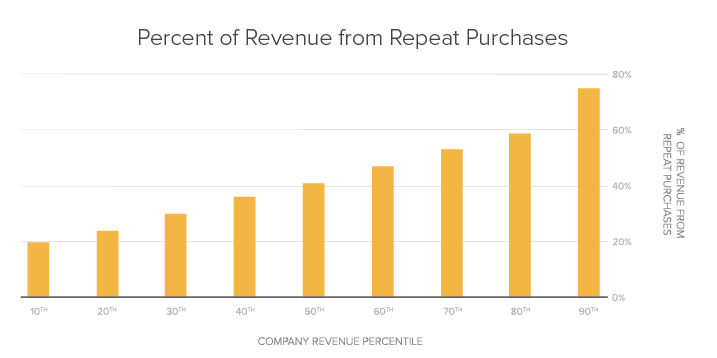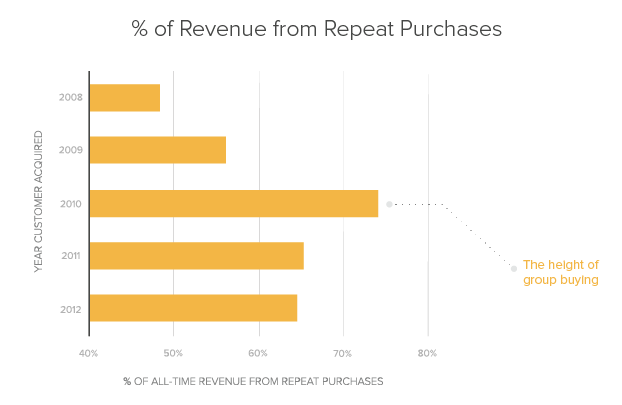Repeat shoppers are worth far more than the average customer. Second time purchasers spend three times as much as first time shoppers, and repeat customers with three or more purchases under their belt spend up to five times as much per visit as a new customer. It’s no surprise then that while repeat shoppers only represent 8% of a site’s visitors, they make up nearly 41% of total online sales. We found the same pattern emerge in our own research. We discovered the typical online store gets 43% of its revenue from repeat purchases. So, just how are best-in-class ecommerce retailers growing this valuable segment of customers?

Don’t Rely on Brand Loyalty
The short answer is this – ecommerce retailers aren’t getting customers back out of a sense of loyalty. PWC’s annual global survey of online shoppers makes it clear that online shoppers are not brand loyalists. While there is quite a bit of variety by country, shoppers are going online for:
- Lower prices and better deals
- Greater convenience
- Ease of comparing and researching products and offers
Brand loyalty isn’t enough to turn a first-time shopper into a repeat customer, online shoppers are too price conscious and fickle for that. Yet, in spite of this challenge, many ecommerce companies are quite good at building a large base of return buyers. If it’s not loyalty then what is it?
The Next-Gen Clue
We found an interesting clue in our benchmark data. Check out the chart below:

Repeat purchases were highest in 2010, during the height of the group buying/daily deals phase. While the daily deals model has lost some of its shine over the past few years, it sparked a trend of ecommerce innovations. Instead of imitating the offline experience, online sellers have started innovating the buyer/seller relationship.
The New Ways to Capture the Repeat Customer
This new breed of ecommerce retailers are tapping into the heart of what customers look for in the online shopping experience.
User vs. Customer Acquisition
The daily deals sites were built on the idea that before you can get a customer, you need to get an email address. While other parts of the model are arguably flawed, this idea continues to influence ecommerce stores. Retailers like JackThreads and One Kings Lane focus on first growing their email list, and then growing revenue.
What can you do to collect more email addresses?
Subscription Ecommerce
Online shoppers love convenience, and subscription ecommerce appeals to just that. Merging product with service, companies like Hello Flo, Dollar Shave Club, and Birchbox are capturing repeat customers by making it a once-and-done decision to buy from them.The lesson here is to stop thinking of customer acquisition as a land grab and start building long-term relationships.
How often do your customers want to hear from you? Should you be reminding them when to reorder from you?
Vertical Integration
One way to escape the race to the bottom is to offer your own unique product line. Vertically integrated business models like Warby Parker, Nasty Gal, and Frank & Oak are able to get out of the price wars by creating their own product line and then selling directly to their customer. While you might not have the cash flow to create your own product line, you can always be on the lookout for ways to create an experience that is uniquely yours.
Can you add personalized touches to your product or marketing? Can you package products together in a unique way?
Pop-up Shops
Sometimes the most convenient thing is to be where your customers are and let them interact with your products. Companies like Fab.com, Zady, and Julep are among the many ecommerce companies venturing offline.
How can you create offline connections with customers? What can you do to put a “face” to your company?
The Bottom Line
These new models go beyond brand loyalty efforts aimed at boosting engagement and mindshare. Instead they’re taking it on themselves to make it super easy to buy again, to offer something that can’t be purchased anywhere else, or to get their products directly in front of consumers’ eyeballs. No doubt these approaches will continue to evolve. Use your customer data to thoroughly understand their shopping behaviors, be willing to test new approaches and technologies, and don’t get too comfortable – ecommerce is always evolving.

